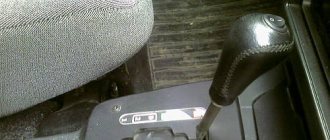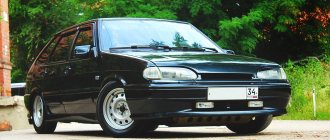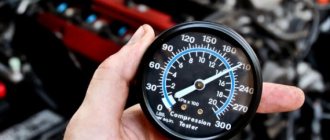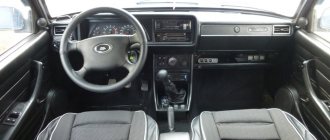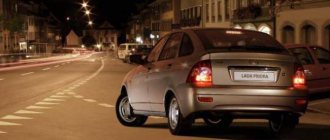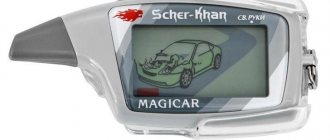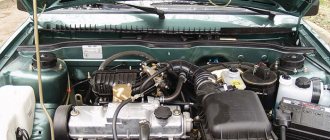We learned that a real limousine can be made from an ordinary pre-wheel drive Lada back in 1994, when at one of the Auto Shows a version of the VAZ 21099, Amadeo 500, extended by half a meter, from the Togliatti company Master Design, was shown.
Photo stolen from the Internet
The idea was bold to the point of absurdity, but... “Ninety-nine” was, to put it mildly, of little use as a base for stretch. However, with the appearance of Amadeo, something clicked in the public consciousness, stereotypes wavered and collapsed. It became possible to think about a limousine based on Lada. All that remained was to wait for a more suitable base model. Which naturally became the “Ten”, VAZ 2110.
The Ten, stretched by 175 mm, called VAZ 21108, is where the history of the Tolyatti company Super-Auto began. It began on January 24, 1997, although no one will remember what exactly happened that day. Then, at the beginning of 1997, VAZ vice-president for technical development (and, concurrently, Kadannikov’s friend) Konstantin Sakharov agreed with the management of AvtoVAZ maintenance to rent one of the buildings of the Togliatti-VAZ Auto Center. They decided to call the company, not without pretension, Super-Auto, because they wanted to make the most prestigious and expensive modifications of the “Ten”. On the list of Super-Auto founders you can find the former director of the OPP Sergei Perevezentsev, the chief VAZ technologist Vladimir Peresypkinsky, the head of VAZ social security Alexander Pushkar and the future chief designer of VAZ Vladimir Guba. The name of the last Super-Auto is still associated...
The company’s website says that the first car was not a limousine, but an ordinary “Ten”, only with an Opel 150-horsepower engine (VAZ 21106). There is information that they also made several samples of a pickup truck from the long-wheelbase Niva. However, this is not confirmed by other sources: 21106 and VAZ 2129 Pickup were produced in those years by the Togliatti company Motorika.
It is known for certain that in 1998 the VAZ 21108 “Premier” appeared - the same stretch on the 2110 platform. It also had a simple 8-valve engine.
I note that the official history of Super-Auto, posted on the company’s website, is replete with ambiguous passages: “a specialized structural entity operating under the auspices of AvtoVAZ OJSC,” “a specialized partner of AvtoVAZ OJSC...” With this, of course, the founders of the company emphasize the proximity to the “parent” enterprise . Legally, Super-Auto did not have and does not have any relation to VAZ; it is a completely independent enterprise, neither a subsidiary nor a structural unit (which, for example, Bronto and OPP were). Although Super-Auto’s informal ties with VAZ are stronger than those of other “subsidiaries”...
In 2004, the 21128 engine with a volume of 1.8 and a power of 105-107 hp was developed for the VAZ 21108. Of course, on the basis of the VAZ, having wasted it. This engine was assembled at the VAZ OPP. As the director of Super-Auto Alexey Rodionov said (he was the one who was involved in the preparation of production ten years ago), the engine turned out to be good, but... unstable. There were problems with the honing of the blocks (this was done by a contractor) and with the quality of the ShPG. As a result, each engine is a lottery; one could go 300,000 km without major repairs, the other barely reached 30,000 km.
Alexey Rodionov, General Director of Super-auto. Started working for the company in 2001 as a support engineer
At first, there weren’t many long “Ten” cars made, a few dozen cars a month. But even this volume was profitable due to the high added value. The VAZ 21108 turned out to be in demand among the VAZ management, who were not supposed to drive foreign cars on official business. But I no longer wanted to drive standard VAZs. With the help of Bronto, they even made two armored vehicles with Opel engines for Vitaly Vilchik, the then director of VAZ. These cars, having changed several owners, are still alive and are now in private hands. True, the armor was removed from them long ago. By 2000, production of 108s jumped to 500 units and became very good; other models were forgotten for some time in the wake of success.
But Super-Auto has never produced real limousines with an interior partition. Although such cars existed in nature, they were single products of other Tolyatti companies, for example, Spetsavto. Super-Auto also had a joint project with Spetsavto – a coupe based on the “Ten” (LADA 21128 Coupe Sport). Unfortunately, not many of these machines were produced at both sites, although the machine turned out to be spectacular.
Photo of the Dozens coupe still hangs in the office of the director of Super-Auto
The designers of Super-Auto then made the front suspension on a subframe, widened the track, boosted the engine to 125 hp... But they managed to assemble only five or six cars - the demand for such an exclusive was low. It's time to refocus on something more widespread.
And such a product turned out to be cars of the “tenth” family with the 21128 engine. For a long time they became the hallmark of the company. And when the Priora appeared, a 105-horsepower engine was adapted for it, this car bore the index 21703.
In the mid-2000s, Super-Auto won a number of tenders and supplied cars to government agencies, primarily the Ministry of Internal Affairs and the Federal Penitentiary Service. Government contracts will henceforth become a good support, but also a reason for a series of minor scandals. They say that the company manages to win tenders by offering by no means the lowest price; on the free market, exactly the same cars are sold cheaper... Then the son of Vladimir Guba, Anton, was at the helm of the Super-auto, who became the de facto (though also de jure) owner companies. But in 2008, he left the position of general director and began to develop a company with a similar name - Super-Auto Holding. However, all more or less significant events in production are still under his control.
There were also slightly adventurous projects. For example, in 2007, Super-Auto, together with the company Apal, planned to produce an ersatz Stalker SUV with a plastic body.
Stalker 2154 Photo stolen from the Internet
The conductors were welded and the purchase of equipment was prepared. But 2008 came - a time that, to put it mildly, was not very suitable for venture projects. Nobody dared to make a risky investment and they didn’t start making Stalker on Super-Auto.
At the height of the 2008 crisis, the model was obviously in demand. After thinking and counting, we decided to make Samara-2 with engines from Priora (21124 and 21126, 87 and 98 hp, respectively). This was rational from the point of view of cost (no original parts were used in the machines) and was in the trend of the then demand. Production volume immediately soared from 200 to 600 pieces per month! And even though the margins of the powerful Samara were small, they allowed the company to go through the 2008-2009 crisis with relatively small losses. And even create a material and financial reserve for future developments.
History of creation
The first prototype of the hatchback, which currently bears the name VAZ-2114, was assembled back in 2000. A year later, the Volzhsky Automobile Plant produced the first pilot production batch of 50 VAZ-2114 cars, and in the same 2001 the hatchback was first presented to the public. But AvtoVAZ was in no hurry to put the new model on the assembly line. The reason was that at that moment the predecessor of the VAZ-2109 was still on the assembly line, which, by the way, was in quite high demand.
Serial production of the updated “nine” in the form of the VAZ-2114 began only in 2003, and for a whole year both hatchbacks VAZ-2109 and VAZ-2114 were produced by the car plant in parallel. In 2004, after the “nine” was discontinued from production, the VAZ-2114 fully took its place.
From that moment on, the car was repeatedly modernized and some changes were made to the design, the interior design, the engine and much more were changed. Various modifications of the VAZ-2114 car were produced not only in Russia, but also in Ukraine. At the end of December 2013, 10 years after the start of mass production, the 5-door hatchback VAZ-2114, like the entire family with the unofficial name “Samara 2”, was discontinued.
Assembly of VAZ 2114 Super Auto
LADA 144 16v Super-Auto is still produced, it is in demand among young people. But, of course, its days are numbered: VAZ has just reported the cessation of production of 2114, inventory will not last long.
Super-Auto also makes pickups based on the long Niva/Lada 4x4 and special vehicles - ambulance, police, rescue. This is an inheritance from the company Motorika, which went bankrupt in 2011, from which the original production equipment was bought. At first, such machines were assembled directly in the workshop of the former Motorika, but it went to creditors for debts and the equipment was moved to the main site.
Special machines are made according to specific orders and as a result of won tenders. For example, at the end of September Super-Auto received a contract for 30 ambulances for the Chelyabinsk region. On average, 30-40 such machines are produced per year.
Taxi project based on Largus, shown at the 2012 Motor Show
Design and construction
From its predecessor, the VAZ-2114 received exactly the same rear end, but with an updated bumper. The front part has undergone major changes - the shape of the headlights has changed, the hood has changed, the radiator grill has become completely different, the bumper has changed, and in addition, moldings on the sides of the body have appeared on the car.
The interior of the car has also changed radically; instead of the nondescript instrument panel that was installed on the “nine”, the hatchback received a so-called Europanel, a steering wheel from the cars of the “tenth” family with the ability to adjust. The car was equipped with a new heater, and the front doors received electric windows.
The first VAZ-2114 cars were equipped with an 8-valve injection VAZ-2111 engine with a volume of 1.5 liters and a power of 77 horsepower. But this was not the only engine that was equipped with the “four”; in 2007, after updating the model, the hatchback received a new 8-valve VAZ-11183 engine with a volume of 1.6 liters and a power of 82 horsepower, in addition, the updated engine complied with the Euro-4 environmental standard. An electric throttle and an electronic gas pedal were also installed.
All in the same 2007, in addition to the new engine, the VAZ-2114 car received a new instrument panel made of a more rigid material, this, on the one hand, increased its strength, and on the other, added extra noise to the already far from quiet car interior. An on-board computer appeared, which displayed various characteristics of the car. Luxury trim levels received central locking and heated front seats. Externally, cars produced after 2007 could be distinguished by moldings located on the sides of the body; now they have become narrower, although the wide version seems more attractive to many.
The next change to the engine in 2009 was made by Super-Avto CJSC, which is a subsidiary of AvtoVAZ OJSC. It was they who began to equip the car with a new 16-valve 1.6-liter engine with a capacity of 89 horsepower. Cars equipped with this engine received the index 211440-24; in addition, this modification received a modified suspension, gearbox, brakes and clutch. Later, the same company installed a more powerful 16-valve engine from Priora with a capacity of 98 horsepower on the VAZ-2114.
The VAZ-2114 hatchback could not boast of a rich variety of trim levels; there were only two of them - standard and luxury. Moreover, the difference between them was not very noticeable, for example, in the luxury version of the VAZ-2114 there were fog lights, a trip computer was installed on the central panel, the door and seat upholstery changed, the front seats received a heating function, and the rear ones were equipped with headrests. That’s actually all the differences between the “luxury” package and the “standard” package.
Basic equipment from a domestic manufacturer
In its minimal equipment, the AvtoVAZ 2114 does not stand out for luxury, but the standard package in the car is enough for comfortable movement both around the city and during long trips. The minimum “Standard” package boasts the following assortment:
- Safety bars at the side doors of the body;
- Side mirrors with anti-dazzle function;
- Standard immobilizer and central locking;
- Function of electric door locking when the vehicle starts moving;
- Inertial seat belts for the front part of the cabin;
- Spare full-size wheel in the standard luggage compartment niche;
- On-board central panel with measuring sensors;
- Option to adjust the brightness of the central panel;
- Power windows for front doors;
- Ashtray for passengers in the back row of seats.
Also among the features of the “Standard” configuration are a combined steering wheel upholstery, as well as an interior reading light, an additional mirror for the passenger in the visor and the ability to adjust the steering wheel for reach.
On the exterior of the car, one immediately notices the stamped 13-inch wheels, as well as moldings and floor fairings. The starting price of the Lada 2114 from the official manufacturer starts from 271,300 rubles, however, for an additional fee, you can enhance the functionality of the car by installing sound insulation in the cabin or fog lights.
Features of the power unit
The first “fourteenth” VAZ models were equipped with injection engines characterized by a displacement of 1499 cm³ and a power of 57.2 kW. Since 2007, under the hood of the Lada 2114 Samara-2 there was a four-stroke gasoline engine with a displacement of 1599 cm³, providing a power of 59.5 kW or 80 hp. With. This engine met the parameters of the Euro 3 eco-standard. The latest modernized model with the index 211440-24 has a sixteen-valve engine with an output of 89 horsepower.
The power supply system using distributive (phased) injection provides high dynamic capabilities, ensuring acceleration to 100 km/h in just 13 seconds. The maximum speed of the VAZ 2114 is 160 km/h. At the same time, the car consumes gasoline economically - only 9 l/100 km in the city.
A special feature of the engine characteristics of this model is the original location of the ceramic catalyst - near the engine itself (unlike its predecessors, which had a catalyst under the bottom). The difference between the cylinder block of the VAZ engine of the “fourteenth” model Lada Samara-2 is its changed volume, achieved by increasing the height of each of the cylinders by 0.23 cm.
Rear shock absorbers for VAZ 2115, 2114 and 2113
The original rear shock absorbers are produced by the same SAAZ. There are no divisions depending on orientation (right/left), and in terms of rigidity they are not very different from the front ones. Reviews about original components are mostly positive, but they often complain about the lack of rigidity and ride height of these shock absorbers. Therefore, racks from a heavier ten are also sometimes installed on the rear wheels. The old part number is 21080291500400. The new number is the same as for Priora shock absorbers.
| Dimensions of rear original shock absorbers for VAZ 2115, 2114, 2113 | ||||
| vendor code | Rod diameter, mm | Case diameter, mm | Body height (excluding stem), mm | Rod stroke, mm |
| 21700291500400 | 15 | 45 | 364 | 230 |
Analogs of front shock absorbers for VAZ 2115, 2114, 2113
The reasons why replacement shock absorbers for VAZ 2115, 2114, 2113 are so popular are still the same - the desire to increase the stiffness of the suspension, as well as raise the rear a little. In particular, this is facilitated by the frequent use of these vehicles for business needs.
| Manufacturer | vendor code | price, rub. |
| Boge | 30-N87-A | 2200 |
| At program | AT 5004-070SA | 1200 |
| Pilenga | SH-P 2711-O | 1000 |
What shock absorbers are better to buy for VAZ 2115, 2114, 2113? If the car is practically not used on the farm for transporting goods, and is operated mainly in urban conditions (or close to them), then you can install the original SAAZ. An excellent analogue are gas-oil shock absorbers from Trialli.
According to the rating of shock absorbers for the VAZ 2114 on PartReview dated 04/07/20, owners prefer products from KYB. Manufacturers PLAZA, SS20 and Bilstein also stand out.
It is also worth paying attention to the famous Russian shock absorbers from SS20. This brand is not so popular among owners of 2115, 2114, 2113, but the struts have good rigidity at low speeds, and at higher speeds they absorb bumps well. For Samara, the shock absorbers from the SS20 are the same as for the Lada Kalina, Priora or Vesta.
Transmission and chassis
All front-wheel drive cars of the VAZ family have a fundamentally similar chassis design. The front suspension is based on the MacPherson system, the rear suspension is a trailing arm. The steering, typical for all models, is rack and pinion.
Lada 2114 Samara-2 is equipped with a manual gearbox. The car is equipped with a five-speed gearbox (gearbox) with a rocker drive. Fundamentally, its design is similar to all those installed on other vase models. The main pair has a distinctive gear ratio of 3.7.
Description of appearance
The company's constructors and designers used new ideas and forms that allowed the model to stand out from the crowd. At first glance at the photo, you will notice the headlights, made in the form of narrow rectangles. This allows you not only to save space, but also to give the Lada 2114 an aggressive look. The company's engineers decided to use simple headlights, without modern LED technology. Of course, because of this, the radius and quality of the glow deteriorate slightly, but not critically.
Between the headlights there is a small radiator grille. This is due to the fact that the power unit does not require a large air flow for cooling. It is in this place that the handle for opening the hood is located, which is quite practical. This solution was invented quite a long time ago, but has only now been implemented. As for the bumper of the Lada 2114 car itself, everything is simple and monotonous.
The automaker's designers used simple plastic and special material to increase the service life of parts. A small feature worth mentioning is an interesting solution taken by the engineers. They raised the bumper slightly relative to the ground. This allows the car to move without problems not only on the city highway, but also on country roads.
On the side of the model there are rear-view mirrors made in the shape of rectangles. This solution allows the driver to monitor everything that is happening behind. The doors of the Lada 2114 car, which are equipped with a special opening mechanism, deserve special attention. This allows you to avoid discomfort when boarding and disembarking passengers.
The company's designers stated that the door opening angle is almost 90°. Not every car is capable of providing this kind of comfort for passengers and driver. Wheel rims are made using casting. This technology makes it possible to obtain very light and durable parts that last for many years.
The rear part of the Lada 2114 car is made using new ideas and solutions. In the photo you can see modified headlights that combine three signals: stop, reverse and turn. This solution is very practical and interesting, and also saves a little space. This kind of technology is used by almost all automakers.
A small feature of the Lada 2114 model is the spoiler, which allows you to increase road grip and dynamic characteristics of the car. The basic vehicle kit already includes the mentioned part. This means that even at a minimal cost, the client will receive additional dynamics and traction of the car with the road.
Some Lada 2114 drivers may encounter a problem during a shopping trip: the tailgate is not equipped with a special hand ledge. This can cause your fingers to get dirty if the door is dirty. If we talk about dimensions, the Lada 2114 is not very big. The length is about 4 m, but the width is 1.5 m. Despite all this, passengers and the driver will be quite comfortable during a long journey.
Video test drive
| VAZ-2114 (LADA Samara) - a five-door hatchback from the Volzhsky Automobile Plant, a restyled version of the VAZ-2109, a continuation of the family under the code name “Samara-2”. The model differed from its predecessors in the original design of the front part of the body with new headlights, hood, radiator trim, bumpers and the presence of moldings. Presented to the public in 2001, serial production - from April 2003 to December 2013 [1]. The interior of the VAZ-2114 was equipped with a new instrument panel (the so-called “European panel”), an adjustable steering column, a steering wheel from the “tenth” family, a new heater design, and front power windows. The car was equipped with a 1.5-liter eight-valve engine (VAZ-2111) with distributed fuel injection. |
Why did it happen so?
Perhaps the automatic requests do not belong to you, but to another user accessing the network from the same IP address as you. You need to enter the characters into the form once, after which we will remember you and be able to distinguish you from other users exiting from this IP. In this case, the page with the captcha will not bother you for quite a long time.
You may have add-ons installed in your browser that can make automatic search requests. In this case, we recommend that you disable them.
It is also possible that your computer is infected with a virus program that is using it to collect information. Maybe you should check your system for viruses.
If you have any problems or would like our support team, please use the feedback form.
The popular AvtoVAZ model was produced at the Togliatti Automobile Plant from 2001 to 2013 and during its production managed to spread throughout all regions of the Russian Federation and some CIS countries.
The car has established itself as a practical and reliable vehicle that, at a low cost, offers an acceptable level of options that ensure comfortable operation.
ATTENTION! A completely simple way to reduce fuel consumption has been found! Don't believe me? An auto mechanic with 15 years of experience also didn’t believe it until he tried it. And now he saves 35,000 rubles a year on gasoline! Read more"
Improved aerodynamics
The VAZ 2114 car excels in aerodynamic characteristics thanks to its well-designed body lines, providing excellent streamlining. As a result of the change in appearance, the drag coefficient has decreased.
External aerodynamic improvements of the Lada2114 Samara-2 also affected changes in the position of the air flow separation point. To do this, the designers had to change the angle of inclination of the most aerodynamically active front part of the car - the hood. The front fenders have also undergone changes.
As a result of the redistribution of the air flow, a smaller part of it is directed under the bottom, while the larger part is directed onto the hood and spreads over the body. These characteristics change the amount of total lift force, as a result of which the front and rear axles are unloaded. The even distribution of lift force allows the hatchback to behave in a balanced manner during high-speed driving.
Owner reviews
Most owners of the super car VAZ 2114 emphasize its modern and attractive appearance. Compared to old foreign cars, this car is cheaper, and according to other reviews from car enthusiasts, this hatchback is easy to drive. The car of the domestic automobile industry is not fastidious in maintenance. You can buy inexpensive parts for it in auto stores.
During the improvement, the power unit turned out to be quite playful.
Also, car owners note the new height of ground clearance, because it now allows them to use the car not only for city trips, but also the ability to drive out of town.
For all car enthusiasts who like to make various improvements to their cars with their own hands, in other words, perform tuning. It is ideal for such car owners to make various upgrades to it, both externally and internally.
General technical specifications
Individual technical characteristics that distinguish the “fourteenth” hatchback from its predecessors are the parameters of the five-door body. Its length is 4,122 meters, width – 1,650 m, height – 1,402 m. The car differs from the base model (VAZ 21093) by a slight extension. Machine weight – 985 kg.
The wheelbase is characterized by a width of the front wheels of 1.4 meters, the rear wheels – 1.37 meters. The trunk (with the rear seat up) has a volume of 330 dm³, with the rear seat folded down – 600 dm³.
The clearance from the asphalt to the crankcase is 160 mm, to the pan the clearance is 10 mm more.
Engine 1.6 l, 8-cl. (Euro-3) Length, mm 4122 Width, mm 1650 Height, mm 1402 Base, mm 2460 Front wheel track, mm 1400 Rear wheel track, mm 1370 Luggage compartment volume, dm 3330 Curb weight, kg 985 Gross vehicle weight, kg 1410 Permissible gross weight of a towed trailer with brakes, kg 75 0Permissible gross weight of the lettered trailer without brakes , kg300Wheel formula/drive wheels4x2/frontCar layout front-wheel drive, engine arrangement front, transverseBody type/number of doorshatchback/4Engine typegasoline, four-strokePower systemDistributed injection with electronic controlNumber and arrangement of cylinders4, in-lineEngine displacement, cm 31596Maximum power, kW/rpm59.5/ 5200 Maximum torque, Nm at rpm 120 / 2700 Unleaded gasoline AI-92 (min) Fuel consumption in the driving cycle, l / 100 km 7.6 Maximum speed, km/h 160 Gearbox Manually controlled Number of gears 5 forward, 1 reverse Gear ratio of the main pair 3.7 or 3 ,9The steering is safety, rack and pinion type, without power assistance. Tires 175/70R13-80(T,N) 165/70R13-79(S,T) Fuel tank capacity 43 litersCar body and suspension
The VAZ 2114 is produced in the form factor of a 5-door hatchback B class with the ability to accommodate up to 5 people in the car. The vehicle dimensions are:
- The case length is 4122 mm;
- Width – 1650 mm;
- Body height – 1402 mm;
- Wheelbase – 2460 mm;
- Car body height – 160 mm;
- Front wheel axle width – 1400 mm;
- Rear axle width – 1370 mm;
- Wheel size – 175/70/R13
Technical part of the 8-valve engine
Structurally, these engines differ significantly from each other, although at first glance this is not the case. Of course, the crankshaft, connecting rods and piston group are all almost the same. The differences are mainly in the upper part, where the valves and camshaft are located. This is the main difference, although if desired, any 8-valve engine can be made into a 16-valve engine, and vice versa. Their cylinder block is almost identical, which means that theoretically you can install any head on it, with one or two camshafts.
An eight-valve engine has one camshaft, while a 16-valve engine has two. In both cases, the camshafts are controlled by the fuel injection system and the removal of exhaust gases from the combustion chambers. In technical terms, everything doesn’t look that complicated.
There are two valves on top of each cylinder: intake and exhaust. The inlet opens to supply fuel to the combustion chamber, the exhaust opens to remove gases. The camshaft regulates the order of their opening. There are protrusions on it in the form of cones, and when rotated they press on one or another valve to open. The engine has 4 cylinders, which means there are 8 valves in total.
pros
Simple is always more reliable, because the fewer parts, the less often the mechanism breaks down. This rule also applies to an 8-valve engine. There is only one camshaft, a minimum of attachments and few structural parts, which makes repairs easier and cheaper. Hydraulic compensators are not used; mechanical pushers are used instead. On the one hand, this simplifies the design and makes repairs cheaper. On the other hand, the thermal clearance of the valves has to be adjusted from time to time.
This engine works great with semi-synthetic motor oil. There are also no strict fuel requirements: both 95 and 92 can be used. Due to its design, the engine is small in size, which means it is easier to service and remove attachments.
Minuses
The main imperfection of this engine is insufficient power. Each cylinder has two valves. Accordingly, intake and exhaust flow slower, therefore the maximum speed is lower, and it will not be possible to develop a high speed. Due to the slow intake-exhaust cycle, there may be a slight increase in fuel consumption. The engine is forced to spend more energy pushing exhaust gases through the only exhaust valve per cylinder.
The disadvantages include increased engine noise when driving at high speed. Camshaft and valve pushers constantly require adjustment of the thermal clearance. If this is not done, production will gradually increase and increased noise will appear. The valves are also adjusted so that fuel consumption does not increase and the engine works better. In general, the engine can be characterized as simple and reliable, but requiring timely maintenance, like any other mechanism.
Technical features of the 16-valve engine
Structurally, an engine with 16 valves is more complex. The cylinder head consists of two camshafts on the right and left, respectively, there are twice as many valves, i.e. 16. There are 4 valves per cylinder: two for exhaust and two for intake. First of all, this gives an increase in power, the efficiency of the engine increases, since exhaust gases are removed faster, and the flow of the air-fuel mixture at the inlet is doubled. At least 20 l. With. You can safely add more power.
